I’ve taken a look at three Fish Tug-Style boats on the Great Lakes and have spoken with the fishermen in depth about their jobs. I also observed demonstrations and helped with the work. As a result, I recommend these general assistive technology ideas. This would work for fishermen suffering from arthritis, or other medical conditions disabling their useful nature in a certain tasks, such as back strength, and arm/hand grip strength.
I can’t make recommendations for a specific fisherman or boat without consulting professional marine mechanics. I’m working on providing general solutions that could help the men on these fishing boats who have medical problems. These ideas should give the fishermen to inspire their thoughts to help produce new ideas that should improve labor on the boat.
The main areas I’m referencing are grabbing things, such as ropes, crates, and hooks with the disability of carpel tunnel or weakened hand grip, walking in and out of, and climbing up and down the boats and delivery trucks, bending and lifting heavy objects such as crates or anchors, and sliding doors open and shut.
A simple but overlooked item is keeping door tracks well-greased and free from debris, this will allow them to open easily. A powered winch could be used to slide them to, but it’s not needed if they’ll open easily on their own. Pictures and descriptions of Velcro grip gloves, wrist hooks, and right-angle handles are enclosed, to address grip strength issues.
Workers should rest when they feel the need to slim down the risks of secondary injuries. However, resting doesn’t have to mean a complete stop of work. Instead, trade jobs around every hour to rest certain muscles while using other rested ones, and work on other things. If fishermen can adjust their equipment to ensure safety, they can reduce the risk of serious injuries while on the job.
Tips for walking and climbing around the boat:
If possible, operate the boat with three workers on board so the captain can remain in the pilot house as much as possible.
If only two workers are operating the boat due to cost and shortage of employees, it’s critical to have hydraulic steering, autosteer, hydraulic gear shifting, and throttle controls that can be operated from the floor of the boat, while setting and pulling nets to decrease the necessity of the captain having to climb out of the pilot house.


Weld a folding grab bar beside the cargo door to open more hand holds when climbing out of the vessel. This will offer stability for the men stepping from the dock to the moving boat and back again.
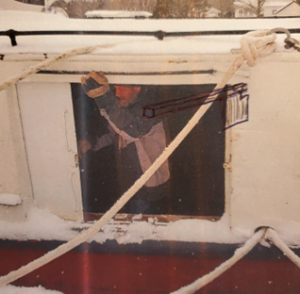

The grab bar, (1×1” 12-gauge square tubing) is hinged to the boat so it can swing up and down away from the boat and towards the dock. A flat plate (5x5x1/4” plate) is hinged to the side of the grab bar so when the grab bar is raised, the flat plate swings down and holds the grab bar in the ‘ready to use’ position. To lower the grab bar after boarding the boat, the worker simply knocks the plate to the side away from the door and the bar falls down easily. When 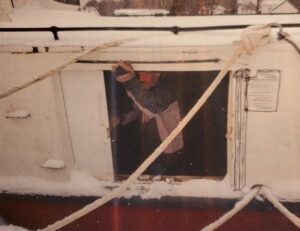

Lifting tips:
A cordless power winch could be moved easily around the boat, as well as lift crates and anchors without being in the way.


A cordless drill can be used on a two-wheel dolly with a lift platform. The powered lift 





A powered lift table could be set up under the fish cleaning table to lower the table and load it with fish. If it were on wheels, it could be turned to extend the table out the door off to the side of the boat beside the net puller. Crates of fish could be easily slid out.
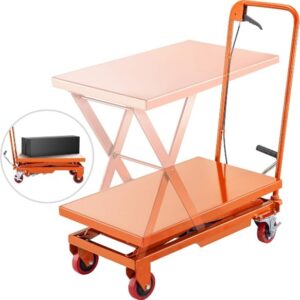

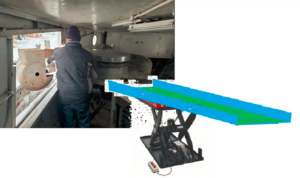

A pickup truck tailgate lift can be attached to a pickup truck’s 2-inch receiving hitch, and winch driven by a 12-volt DC motor powered by the vehicle’s electrical system. The Tailgate Hitch Lift van hoists crates weighing as much as 700-lbs from ground level to the truck-bed level in a matter of seconds!
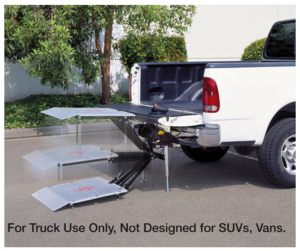

A 12V electric truck-mounted crane could easily lift crates of fish from the dock, swing around a full 180 degrees, and set the crate on the truck. It could be built with a 12-volt linear actuator and winch system, and simply operate from the vehicle battery. When workers arrive at the dock after a long day’s work, the boat crane will lift 80-lb boxes of fish out of the boat. As the fish are picked up from the nets, they are packed into 80-lb boxes with ice.


The full boxes are then stacked up in the back of the boat, and then placed on the dock. A crane will then lift the boxes, then swing around and lower the boxes to the truck bed.
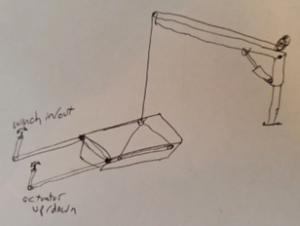



Grip support and assists:
Grip-assist gloves or cuffs help workers with weakened or impaired grip strength to hold their tools securely. They use Velcro to hold the hand in a fist without straining the worker’s muscles. Knives, hammers, wrenches, and other frequently used hand tools have small-diameter handles, that can be even more difficult to hold securely, let alone the difficulty of large diameter tools. This grip assist glove is designed for workers who have limited use of their hands or fingers, due to carpel tunnel syndrome, arthritis, or a crippling accident or injury.


Wrapping pipe foam insulation around small handles will also improve grip-ability for those with arthritis in the hands or wrists, along with keeping the wrist in a straight position.
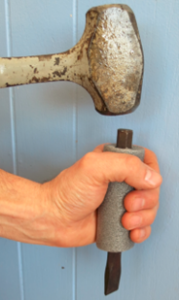

A Weight-lifting Hook Grip consists of a 2 or 3-inch, cushioned Velcro wrist strap that’s attached to a padded, 2-inch-wide metal hook, over which the worker cups his hands. The hook is what holds the object, (e.g., a bucket, fish crates, anything with a handle), which reduces the amount of grip strength needed to lift the object.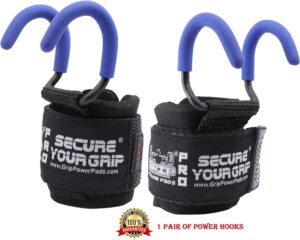

Lifting Rod Hooks Heavy Duty Wrist Wraps
Check in next month as we follow up with more tips!
